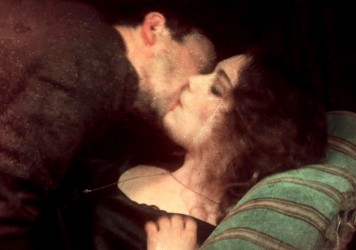
Director Matthew Rankin discusses his experimental debut feature The Twentieth Century.
Filmmaker Matthew Rankin describes his debut feature as a “Heritage Minute from Hell”. For those unfamiliar with the long-running Canadian series, Heritage Minutes are a collection of short films depicting important moments in the nation’s history, such as Dr Wilder Penfield’s discoveries in neuroscience (a personal favourite, he literally poked at living people’s brains) and the construction of the hockey arena Maple Leaf Gardens in Toronto. Rankin says that Heritage Minutes as Canada’s ‘white elephant’ art and his films are the termites digging and fighting to expose their sinister underbelly.
Rankin was born and raised in Winnipeg but has spent a lot of time living and working in Quebec. He’s associated with the Winnipeg Film Group and has a similar style as Guy Maddin. With a background in history and animation, he uses celluloid, avant-garde techniques and expressionistic montage in his films, which include shorts like The Tesla World Light and Tabula Rasa, starring the synth pop artist Grimes.
The Twentieth Century, which recently premiered at Quebec’s Festival du Nouveau Cinéma in one of Canada’s oldest cinemas – an appropriate venue for this time-busting vision – is a gonzo retelling of the early days of Canada’s tenth prime minister, William Lyon Mackenzie King. Rankin began reading King’s diary because of his fascination with journaling. “He was into ectoplasm and obsessed with his dog and his mother,” he explains. “I knew those three things, and I thought, ‘This is a guy I can relate to!’” The film explores King’s first campaign through a variety of strange trials and tribulations, including an insatiable foot fetish, an overbearing mother and the existential threat of Quebec’s distinct culture.
Inspired by King’s diaries, Rankin wanted to examine the moment when utopian ideas from the early 20th century “shifted into the nightmarish situation we find ourselves in now.” He was particularly inspired by a speech given by another prime minister, Sir Wilfred Laurier, who boldly declared that, “the 20th century shall be the century of Canada.” This strange and rather vague statement captured Rankin’s imagination and helped drive the film’s exploration of Canadian identity. Yet Rankin, who himself studied history, is under no false illusion that his film represents a historical truth. “It’s purely an artistic engagement with the past,” he says.
He returns to the idea of the Heritage Minutes, which he suggests are not celebrations of Canadian accomplishments as much as a way to undermine the growing artistic and social independence of Quebec in the 1990s. “They were devised as a weapon,“ he explains, “sort of weaponising Anglo Canadians against Quebec nationals.” By positioning Quebec as a beacon of modernity and progress, Rankin’s film turns the tables on English Canadian audiences, who have come to see the province at its most exaggerated worst in the past half-century.
“I believe in the Luis Buñuel dictum about how in every film he made, he tried to insert a single grain of sand into the collective eyeball,” Rankin says. “He felt that if he could irritate people, maybe he could trick them towards a new way of seeing.”
It’s not that The Twentieth Century serves as an irritant, but it is often overwhelming. Its visual style is unusual, its comedy tar-black and its politics chaotic. While it focuses on specific characters from Canadian history, the film nonetheless has a broad appeal as a deconstruction of nationalist thought.
In one sequence, a series of candidates pledge their allegiance to the Great Disappointment (aka the Canadian flag) and engage in a series of mediocre competitions to test their passive-aggressiveness and thresholds for shame. Far from being a representation of Canada’s best vying for leadership, the sequence reveals a succession of pitiful and desperately vain men who act as though becoming prime minister is their birthright. They wish to govern the country not to make it better but to facilitate their own ambitions.
Rankin’s film also draws from a range of aesthetic inspirations, from early animation to Canadian visual arts. There are several animated sequences in the film whose silhouette technique borrows from the works of Lotte Reiniger, best known for 1926’s The Adventures of Prince Achmed. Rankin was also influenced by Expo 67’s Pulp and Paper Pavilion, a group of seven painters, as well as Lauren Harris and York Wilson due to their “very metaphoric approach to the natural world.”
From the Heritage Minutes to other modes of Canadian self-representation, Rankin views the Canadian national identity as hyper-focused on self-pleasuring. “Canada is just self-gratifying itself to death,” he explains. And, in a way, so is the rest of the world. By focusing on meagre accomplishments and pomp and circumstance, we’ve lost touch with dreaming of a better future. While Rankin mocks some of the early 20th century conviction about a brighter future, the loss of that sunny idealism is also a deep blow to radical and lasting change.
Published 14 Oct 2019

The filmmaking duo discuss their beautiful, bewildering fever dream.

Porn barons, rebel poets and teen sexuality are all part of this exciting cinematic crop.

Along with their daughters, co-directors John Adams and Toby Poser are winning fans with their alternative, homespun approach.